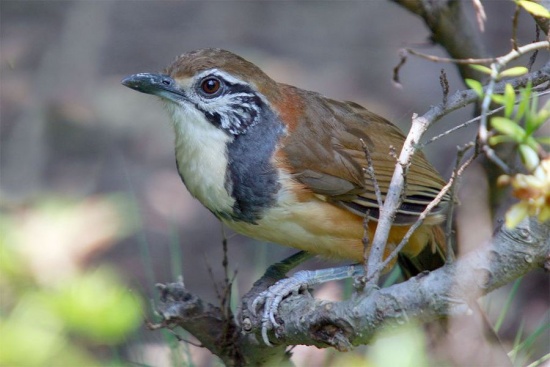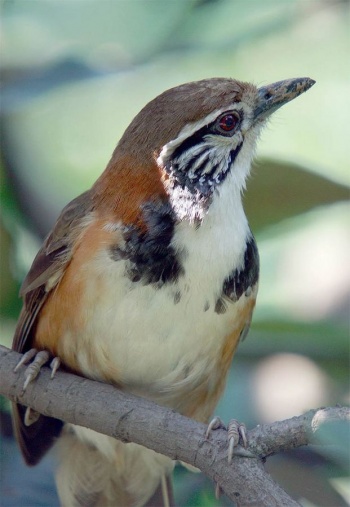Alternative names: Black-gorgeted Laughingthrush; Necklaced Laughingthrush; Gorgeted Laughingthrush
- Pterorhinus pectoralis
Garrulax pectoralis
Identification
With 26.5 to 34.5 cm a large Laughingthrush, very similar to Lesser Necklaced Laughingthrush which has a similar range. Note especially:
- Thick bill with pale base
- Dark eye with yellowish eye-ring
- Greyish legs
Has also a plainer crown, pale lores (expect in some birds), a bolder black line behind eye and a broader moustachial reaching base of bill, streaked ear-coverts and a blackish carpal patch.3
Distribution
Found in south-east Asia from the Himalayas (Nepal, India, Bhutan) to Myanmar, South to Thailand, Laos and Vietnam and east through Southern China, including Hainan].1Introduced on the island of Kaua'i (Hawaii)
Common in parts of its range and not globally threatened.1
Taxonomy
This species is sometimes placed in the genus Ianthocincla, or Garrulax
Subspecies
Clements2 accepts five subspecies:
- P. p. pectoralis in central Nepal east to Bhutan, northeastern India, eastern Bangladesh, northern, western, and central Myanmar, and southern China (western Yunnan)
- P. p. subfusus in South-eastern Myanmar, Thailand and North-western Laos
- P. p. robini in Southern China, Northern Vietnam and North-eastern Laos
- P. p. picticollis in Eastern China
- P. p. semitorquatus on Hainan
Habitat
Found in broadleaf evergreen forest, mixed deciduous forest and mixed broadleaf-coniferous forest. Also in secondary growth, bamboo and plantations. Recorded up to 1830m, occasionally to 2000m.1
Behaviour
Diet
Feeds mostly on insects and fruits. Often found in large flocks, up to 25 birds and often associated with White-crested Laughingthrush and Lesser Necklaced Laughingthrush, also with Green Magpie and Greater Racket-tailed Drongo 1,3
Breeding
Breeding season from February to August. The nest is placed from ground-level up to about 6m in a bush, a small tree, bamboo or sometimes among grass. It's a large and bulky shallow cup made with dead bamboo, leaves, moss and twigs. Lays 3 to 7 eggs. Brood parasitism by Chestnut-winged Cuckoo recorded.1
Movements
Resident species, no movements known.1
Reference
- del Hoyo, J., Elliott, A. and Christie, D.A. eds. 2007. Handbook of the Birds of the World. Vol. 12. Picathartes to Tits and Chickadees. Barcelona: Lynx Edicions. ISBN 84-96553-42-6
- Clements, J. F., T. S. Schulenberg, M. J. Iliff, S. M. Billerman, T. A. Fredericks, J. A. Gerbracht, D. Lepage, B. L. Sullivan, and C. L. Wood. 2021. The eBird/Clements checklist of Birds of the World: v2021. Downloaded from https://www.birds.cornell.edu/clementschecklist/download/
- Rasmussen, P.C. and Anderton, J.C. 2005. Birds of South Asia. The Ripley Guide. Washington D.C. and Barcelona: Smithsonian Institution and Lynx Editions. ISBN 84-87334-67-9
Recommended Citation
- BirdForum Opus contributors. (2024) Greater Necklaced Laughingthrush. In: BirdForum, the forum for wild birds and birding. Retrieved 28 April 2024 from https://www.birdforum.net/opus/Greater_Necklaced_Laughingthrush





